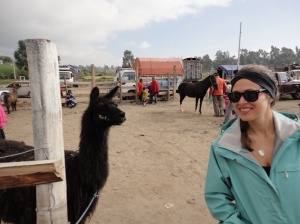Arriving in Quito late at night, Ryan and I were greeted by the millions of white lights sparkling across the city and up into the surrounding mountains. I truly believe that even the ugliest of cities can come alive at night, glistening like a string of Christmas lights on a tree. The same goes for Quito, and I felt optimistic for our time in the city as our driver from the airport told us how much he loved Quito, using hand actions to passionately describe the way he felt about his city.
Ryan and I are staying in Mariscal, which is the tourist disctrict, packed with restaurants and bars pumping top 40’s and techno music. We spent much of our first day wandering the the area, and wishing we were back in Medellin. My sprained ankle, coupled with an upset stomach, a fairly mediocre hostel, and the cloud of pollution that seemed to be hovering over us led me to believe that it was simply not my week. It wouldn’t be an adventure if everything was awesome 100% of the time though, right?!
After hunkering down in Juan Valdez (one of the many coffee shops we frequented in Colombia) to discuss how much we missed Colombia, we decided to put that behind us and figure out what there was to do in Quito and the area that we weren’t already doing in the days following the Galapagos Islands. We booked a day tour to the Quilotoa crater for the following day, and as it turns out Ecuador is pretty awesome.
 We headed out early in the morning, driving south on the Panamerican highway towards the town of Latacunga. From there, we turned off the highway and headed up into the mountains. On our way to Quilotoa, we stopped at a traditional Indian market, where we saw the native people trading all sorts of animals; sheep, cows, pigs, and llamas. We saw many women who were less than 5 feet tall hauling pigs along behind them that must have weighed nearly double what each of these petite Ecuadorian women weigh. It was a whole different sort of insanity. From there, we headed to a food and artisan market, where we were served a hearty 2 course meal that I didn’t even come close to finishing, along with a drink for a whole $2.50.
We headed out early in the morning, driving south on the Panamerican highway towards the town of Latacunga. From there, we turned off the highway and headed up into the mountains. On our way to Quilotoa, we stopped at a traditional Indian market, where we saw the native people trading all sorts of animals; sheep, cows, pigs, and llamas. We saw many women who were less than 5 feet tall hauling pigs along behind them that must have weighed nearly double what each of these petite Ecuadorian women weigh. It was a whole different sort of insanity. From there, we headed to a food and artisan market, where we were served a hearty 2 course meal that I didn’t even come close to finishing, along with a drink for a whole $2.50.
We drove for about another hour, stopping occasionally to photograph the countryside of Ecuador. The mountains are bare of both snow and vegetation, but have bundles of a local grass growing haphazardly. The indigenous people used to construct their homes from this grass, and although only a few of these homes are left, we had the opportunity to see one of them. It gets quite cold at 4,000 meters above sea level, so this left me feeling pretty thankful that I’ve always had a sturdy roof over my head. The Ecuadorian countryside seemed fairly unimpressive at first, until I saw the massive mountains poking their heads above the clouds. Then, as we continued, we began to see deep gullies that lead us to the Quilotoa crater.
 The crater is hidden from view until you walk down a set of steps, and reach your viewpoint. I hobbled slightly behind the group, eyes on where I was walking, and when I looked up, my jaw dropped as I saw one of the most spectacular pieces of scenery I’ve ever seen. Photos simply do not do the size and magnificence of the crater justice. The crater is now an inactive volcano, and the lake within in the crater is said to be about 250 meters deep. The water is a perfect turquoise colour that changes as the clouds move above it. We watched the clouds drift overhead for a few minutes and it was a pretty incredible view. After watching the clouds move across the lake, and taking numerous photos from all different angles, I felt pretty good about Ecudaor.
The crater is hidden from view until you walk down a set of steps, and reach your viewpoint. I hobbled slightly behind the group, eyes on where I was walking, and when I looked up, my jaw dropped as I saw one of the most spectacular pieces of scenery I’ve ever seen. Photos simply do not do the size and magnificence of the crater justice. The crater is now an inactive volcano, and the lake within in the crater is said to be about 250 meters deep. The water is a perfect turquoise colour that changes as the clouds move above it. We watched the clouds drift overhead for a few minutes and it was a pretty incredible view. After watching the clouds move across the lake, and taking numerous photos from all different angles, I felt pretty good about Ecudaor.